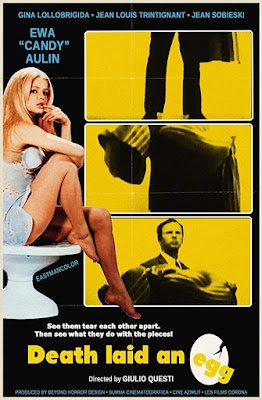Death Walks at
Midnight (1972) This nifty thriller from director Luciano Ercoli has enough
turns to keep you guessing until the end. Top fashion model Valentina (Nieves
Navarro, aka: Susan Scott) takes an experimental hallucinogen for money and has
visions of a brutal murder with a spiked gauntlet. As Valentina delves deeper
into the mystery, she spots the murderer from her nightmares, which might just
lead to her doom. Fearing she will be the next victim, she tries to convince
her artist boyfriend and police, but they dismiss it as effects of the drug.
Only a lone reporter appears to be her ally. The film features a pair of thugs,
including a manic laughing assassin, in a climactic rooftop fight. Spoiler
alert: Don’t expect Death to appear at midnight. In the context of the movie, he
shows up whenever he pleases.
Rating: ****. Available on Blu-ray, DVD and Amazon Prime
The Fifth Cord
(1971) Director Luigi Bazzoni’s taut giallo film keeps us engaged throughout, featuring
Franco Nero as alcoholic journalist Andrea Bild. As the intrepid reporter gets
closer to the truth behind a series of murders, he gets deeper into hot water
with the cops and his superiors. As he appears in the film, Andrea isn’t the
most sympathetic of characters. He has an abusive streak, and still holds a
torch for his ex-wife Helene (Silvia Monti), while spending time with his
girlfriend. The Fifth Cord also
features another (surprise, surprise) exceptional score from Ennio Morricone
(Where would gialli have been without him?).
Rating: ****. Available on DVD
Perversion Story
(aka: One on Top of the Other) (1969)
This solid suspense movie, set in San Francisco, plays like a classic film noir,
albeit with more explicit thrills and a swinging ‘60s vibe. Jean Sorel stars as
George, a doctor in a loveless marriage. Marissa Mell stuns in a dual role as
George’s asthmatic wife Susan (Marissa Mell) and femme fatale Monica Weston.
When Susan suddenly dies from an accidental overdose, all signs point to him as
the likely culprit. Monica, a stripper at a nightclub, might be the link he
needs to clear his name. Director/co-writer Lucio Fulci’s film is stylish,
sexy, and packed with enough crazy plot twists to keep you entranced.
Rating: ***½. Available on DVD
All the Colors of the
Dark (aka: They’re Coming to Get You)
(1972) Sergio Martino’s horror/giallo hybrid combines mystery with shocks, in
the tale of a woman who becomes mixed up in the affairs of a coven of witches. Edwige
Fenech stars as Jane, a woman traumatized by the loss of her unborn baby in a
car crash. She repeatedly suffers nightmares of being stabbed by an unknown man,
and her constant state of fear begins to forge a rift with her fiancé Richard
(George Hilton). The bad dreams become too real when the visions invade her
waking hours, and she finds herself pursued by the unknown assailant. Her neighbor
proposes a novel approach to her problem, inviting her to a satanic mass.
Although it appears to solve her problems with intimacy, it creates new issues.
Soon, she’s running for her life from the demonic cult. Martino’s film is
unsettling and discombobulating, creating the illusion of a waking dream.
Warning: Pet lovers might consider steering clear, or at
least looking away during the animal sacrifice sequence about midway through
the film.
Rating: ***½. Available on DVD
Evil Eye (aka: The Girl Who Knew Too Much) (1963) In
this fascinating early giallo film from director Mario Bava, Letícia Román plays
an American tourist in Rome, Nora Davis, who seems to attract trouble from the
moment she steps off the plane. She has a run-in with a drug smuggler, and her aunt
dies during the first night in town. Things get worse when she witnesses a
murder in the middle of a town square. The local police don’t believe her
because she appears to be drunk. Only Dr. Marcello Bassi (played by a youthful
John Saxon in a rare romantic role) stands in her corner. Román and Saxon are
an appealing couple, who team up to solve the mystery behind a series of
murders. Tense and visually gripping (featuring glorious black and white
cinematography by Bava), Evil Eye
(along with Bava’s Blood and Black Lace
from the following year) is an excellent introduction to the genre.
Rating: ***½. Available on Blu-ray and DVD
Death Laid an Egg
(1968) Even in a genre known for oddball titles, this is an oddball title.
Sadly director/co-writer Giulio Questi’s thriller doesn’t quite live up to its
goofy promise. Anna (Gina Lollobrigida) owns a family estate with an
experimental chicken farm, while her husband Marco (Jean-Louis Trintignant)
manages operations with the controlling company. His extracurricular activities
involve killing prostitutes and lusting after his young secretary, Gabrielle (Ewa
Aulin). Death Laid an Egg might not be
much of a murder mystery, and moves at a glacial pace, but it might be worth a
look for its idiosyncratic touches, including inventive camera angles, funky
editing choices, and a batch of headless/boneless chickens created on the farm.
Rating: **½. Available on DVD


















